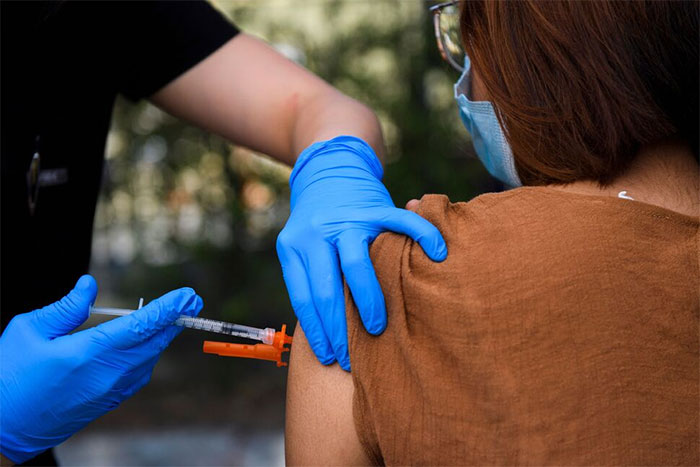The Covid-19 vaccine is currently viewed as a crucial solution for the world to overcome the Covid-19 pandemic.
However, the need for booster shots for millions of people continues to create hesitation among many. Therefore, instead of vaccinating each individual to activate the immune response, scientists are exploring the potential of a “self-spreading” vaccine that could transmit immunity from person to person, similar to how viruses spread, thereby generating antibodies and reducing the number of people who need to be vaccinated.

Vaccination against Covid-19 for residents in Los Angeles, California (USA). (Photo source: AFP/TTXVN)
An article published on dailymail.co.uk discussed researchers considering the potential development of vaccines that can transmit immunity between individuals. According to the article, if this becomes a reality, it may only require 5% of the UK population—equivalent to 3 million people—to be vaccinated. The remaining individuals would then “absorb” the vaccine as it “spreads” rapidly across the country through airborne droplets during close contact, similar to the mechanism of cold or seasonal flu transmission. More importantly, this could lead to community immunity within weeks rather than taking months for millions to be vaccinated and develop immunity against Covid-19.
About 10 research organizations in the US, Europe, and Australia are investigating the potential of a “self-spreading vaccine” following the Covid-19 pandemic. Most studies focus on transmission from animals to animals or from animals to humans, with human studies so far concentrating on whether this concept is safe in principle. The research is receiving funding from prominent grant organizations, including the US National Institutes of Health.
Creating a vaccine that can transmit immunity requires finding ways to manipulate a virus or bacteria so that it can easily spread from person to person without causing serious illness. Two options are currently the focus of research. The first involves designing a very mild pathogenic virus in the lab with low virulence, yet still capable of rapidly infecting large populations to activate the basic immune response to produce antibodies against the infection. The other option is to manipulate some DNA from a new dangerous pathogen within a relatively harmless but highly contagious virus, such as the common cold virus. Exposure to DNA segments inside the harmless virus as it spreads through the population would prompt the immune system to be on guard against the actual, more serious pathogen without causing any severe illness.
With both strategies, the vaccine would only need to be administered to small groups of people in different regions of the country. These individuals would then “transmit the vaccine” to others in their local community. Scientists have demonstrated that this approach can be effective. In 2000, researchers in Spain manipulated a deadly virus in rabbits by vaccinating 70 rabbits with a self-spreading vaccine and releasing them into the wild, where they quickly spread it to hundreds of others, thereby preventing an outbreak. Similar techniques are currently being tested on pigs in various regions of Europe to prevent the spread of African swine fever, which can devastate livestock.
Researchers are now considering using “self-spreading vaccines” in animals to prevent viruses from infecting humans. One of the most advanced projects, funded by the US Defense Advanced Research Projects Agency, aims to protect its military personnel operating in West Africa against Lassa fever—a viral disease originating from rodents. An international team of researchers, including some from the UK, is also studying a trial “self-spreading vaccine” that could prevent the virus from transmitting from rodents to humans. Although there is currently no research documentation related to “self-spreading vaccines” for human use, this is something that UK government officials are exploring as a viable option to combat seasonal flu.


















































